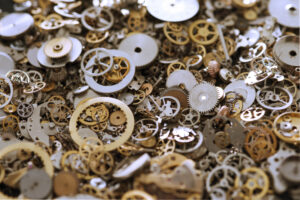
What’s your scrap brass worth? As with other types of scrap metal, the value of scrap brass depends on a few factors. For one, fluctuations in the global scrap metal markets will affect how much you can earn from selling old fixtures, piping and other kinds of scrap brass. Then there’s the type and condition of the brass itself. It’s important to understand how grade and contamination affect scrap brass value so you have all the information you need to get the best possible price for your scrap brass.
Scrap Brass Grades
Brass is a non-ferrous alloy made from copper and zinc. There are many different kinds or “grades” of brass because these components can be combined in different ratios, and other metals may also be included (like tin and lead). Brass that has a distinct reddish color generally has a high concentration of copper (80% or more), while yellowish brass might be 60 to 70 percent copper and have more zinc and/or other metals than red brass.
You might see brass grades described in categories like “mixed brass” or “yellow brass.” (Mixed brass is a “catch all” grade that can include a combination of scrap including faucets, fittings and all forms of brass based metal.) Brass can also be described using production grades such as 70/30, 85/15, 95/5, etc. For example, 70/30 brass is 70% copper and 30% zinc.
Adjusting the composition affects how strong, flexible and expensive the brass is. Scrap brass can include anything from plumbing scrap to fittings to manufacturing scrap, and it can be difficult to tell what kind of brass you have just from looking at it. Any reputable scrap metal dealer can help.
Getting the Best Price for Your Scrap Brass
Scrap brass is highly recyclable and can be reused over and over without losing quality, so scrap metal dealers are always in the market for brass. Naturally some grades are more valuable than others. If you have a lot of reddish scrap brass, you’re in luck because brass with a high copper content is worth more than yellow brass. (Or you might be even luckier and you actually have bronze scrap instead of brass—more on that below.)
Whatever grade of brass you have, the key to getting the best possible return for this scrap is to make sure it’s segregated and cleaned properly. It should be free of contamination such as steel attachments, zinc, or other types of metals. Production grades of brass should be free of any cutting oils or liquids, filings, turnings, etc.
It’s also important to sort through any brass material to remove bronze, which may also be called “composition.” Like brass, bronze is an alloy but is made primarily from copper plus tin and/or other metals. Because of its high copper content (typically 88% or higher), bronze is even more valuable than brass. It is not easy to distinguish from brass, but again, any reputable scrap dealer should be more than willing to show you the difference. Clean composition can bring as much as .20 to .30 cents per lb. premium over mixed brass.
It’s also worth noting that scrap metal can look like brass but actually be composed of steel, aluminum or another metal that’s covered with brass plating. Brass-plated scrap will not yield the kind of prices that you can get for solid brass. The brass coating would have to be removed from the metal underneath before both materials could be recycled, and that’s too cost-prohibitive to make brass-plated scrap valuable for recyclers.
How much is your scrap brass really worth?
Miller Recycling is your resource for everything related to scrap metal recycling. Should you have questions on how to best sort your scrap brass, feel free to contact us or stop by our facility. Please note we are continuous buyers of all grades of scrap metals, and provide on-site containers and pickup service for commercial clients. Contact me today with questions.

